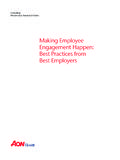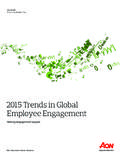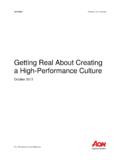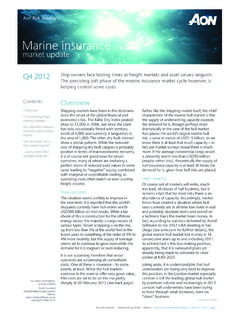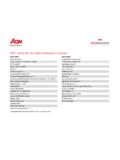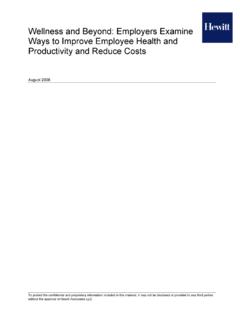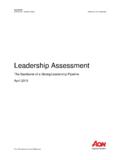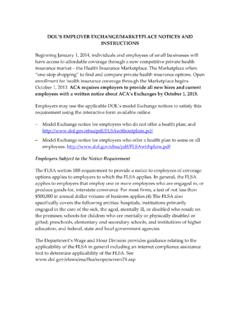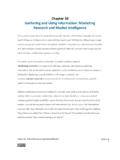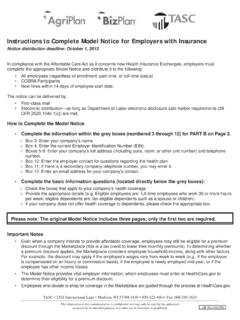Transcription of Creating a Competitive Marketplace - Aon
1 Exchange Solutions Creating a Competitive Marketplace How the Corporate Exchange Can Help Employers Break Away from the Health Care Trend Creating a Competitive Marketplace How the Corporate Exchange Can Help Employers Break Away from the Health Care Trend Contents 1 Executive Summary 4 A New Paradigm and New Choices 5 Four Decision Paths 7 The Competitive Marketplace of a Corporate Exchange 8 How the Corporate Exchange Works 10 Changing Employee Behavior 11 The Retiree Exchange A Model that Works Today 12 The Corporate Exchange Is Not Just for the Private Sector 13 Going Forward Executive Summary Employers offering health coverage today find themselves at a crossroads, where major trends are converging to create both new burdens and new opportunities. First, annual health care cost increases have compounded to a level that places significant pressures on businesses'.
2 Ability to remain Competitive and still be profitable, on the wages and other benefits that employers provide to their employees, on the share of employees' personal spend on health care, and on shareholder value. An increasingly unhealthy population makes it both more critical and more difficult to control health risks and costs. Second, the Patient Protection and Affordable Care Act (PPACA) is changing the health care landscape as we have known it. In January 2014, large employers will face new responsibilities for the health coverage they offer their employees, as well as financial penalties if they fail to meet those responsibilities. In that same time frame, new state health care exchanges established under the PPACA will launch new health insurance marketplaces to individuals and small businesses, where coverage can be purchased with no medical underwriting or pre-existing condition exclusions.
3 And if an individual has no other coverage and qualifies on the basis of family income, federal assistance will be available to help pay for premiums. Large employers cannot purchase health coverage for their employees through the public exchanges until at least until 2017, when each state exchange will be given the discretion to admit employers with more than 100 employees. As these dynamics unfold, employers now need to move beyond just compliance with the health reform law, and begin to focus on determining the role they want to play in providing employee health coverage in the future and the strategies to realize that vision. The old approaches are failing. What employers need and are searching for are new and innovative ones. New Choices Health reform offers one new approach: It gives employers the option to stop offering health insurance coverage by paying free rider penalties while their employees obtain individual coverage through the state exchanges.
4 While appealing to some organizations, this approach is a step too far and too disruptive for most. A survey conducted in 2011 found that nearly all employers (94%) are committed to continuing to offer health benefits Those employers that continue to offer health coverage can engage in annual plan design reevaluation and vendor negotiation to try to lower their future cost trend to a modest degree. They will also look for ways to reduce the demand for health care services. For example, employers can put a greater emphasis on health screening and wellness activities to improve and maintain the health of employees and their families with premium reductions or other incentives. 1 Aon Hewitt Corporate Health Care Exchange Survey: The Time is Now Rethinking Health Care Coverage, 2012. Creating a Competitive Marketplace 1. Another solution attracting a great deal of employer interest is the concept of offering health coverage through an innovative private Corporate Exchange.
5 The exchange allows employers to join forces to create a Competitive Marketplace for health insurance based on consumer choice, which will encourage insurance companies to drive the system toward greater efficiency. The Corporate Health Care Exchange A health care exchange is a Marketplace that connects insurance companies with individuals or employees wishing to purchase health insurance. The more exchange participants, the greater the economies of scale that increase carriers' ability to offer Competitive prices. In this insurance Marketplace , as in every consumer market, the element of competition will ultimately reduce prices. While there are different configurations of exchanges, the Aon Hewitt Corporate Exchange is a first-of-its-kind private- sector approach that uses a multi-carrier model to maximize competition among insurers on the basis of consumer choice.
6 This dynamic will enable employers to establish a health care spending model comparable to an annual salary increase, as opposed to the common annual health care trend increase of 7% to 10% and without necessarily shifting more costs to employees. A company that participates in Corporate Exchange no longer designs and manages its health care plan that function falls to the exchange. The employer determines how much of the cost of coverage it is willing to subsidize. Employees use this subsidy to select both the plan design and the insurance provider that best fit their needs. Thus, the exchange gives employers a greater ability to predict their costs. In addition, the employer subsidy is no longer hidden employees can now see the employer's full monthly or annual subsidy. Employers choosing this approach move from a self-insured plan to an insured group health plan, thereby transferring risk and cost accountability to the insurers.
7 This increases predictability, minimizes volatility, and eases the employer's administrative burden. The employer health benefits contribution, or subsidy, is transparent. 2 Aon Hewitt How It Works Employers choose the level of fixed subsidy they make available to employees for the purchase of coverage through the Corporate Exchange. Employees choose among an array of benefit levels. For each of these benefit levels, insurers offer rates to each employer based solely on the employer's group experience; there is no pooling of risk among employers. Insurers then compete for the enrollment of employees on the basis of price, provider network, performance, and other value-added features. Benefit designs are standardized, and a risk adjustment mechanism compensates insurers for taking on enrollees with greater health risks from insurers that enroll a better-than-average risk.
8 Under this model, the Corporate Exchange can use Competitive forces to limit future trend increases to the benefit of both employers and employees. Employees also have a wider choice of options and carriers. The Value Proposition: Win, Win, Win Risk transfer and predictability Employers Trend mitigation through competition, efficiency, and best-in-market contracting Focus on health and productivity Greater choice of plans and carriers Employees Superior customer experience Flexibility to tailor benefit/contribution trade-offs Market share opportunity (and risk). Earnings potential Carriers Product innovation and control Attractive risk pool Sometime after 2014, if and when there is a viable individual market, the Corporate Exchange may evolve in the direction of individual policies with employer subsidies that provide full portability of coverage if the employee leaves the company.
9 This portability does not exist today with employer-sponsored health insurance except in the limited COBRA window, and the employer still retains the claims liability. A functioning individual market enabled by an exchange would replace the need for COBRA coverage and eliminate the hidden subsidy between COBRA rates and actual claims experience. For many employers now looking toward the future, the Corporate Exchange is an idea whose time has come. The multi-carrier Corporate Exchange model creates a Competitive Marketplace unlike anything that exists today, while offering employees greater choice, control, and a superior user experience. In a world of health care fraught with uncertainty, Corporate Exchanges can help provide employers with more predictability and less volatility. Creating a Competitive Marketplace 3. A New Paradigm and New Choices Employer-sponsored health care coverage, the source of health coverage for nearly 170 million individuals2 in the , is at a crossroads.
10 In a little over a year, for the first time employers with 50 or more employees will have to begin paying a $2,000. penalty for each employee if: 1) the employer does not offer all full-time employees a health plan that provides what the law calls minimum essential coverage ; and 2) even one employee becomes eligible for federal assistance in paying premiums ( premium credits ). A $3,000 penalty applies for each employee if the minimum essential coverage is offered but is considered unaffordable and an employee qualifies for federal premium assistance through one of the state exchanges. In the same time frame, new opportunities to purchase coverage will emerge. New marketplaces will become available in every state, with either the state Creating its own health insurance exchange or leveraging the federal government exchange option. State and federally based health exchanges are intended to offer an efficient Marketplace for individuals and small businesses to purchase coverage from private insurers, with federal subsidies available to assist low-income individuals without other coverage.
